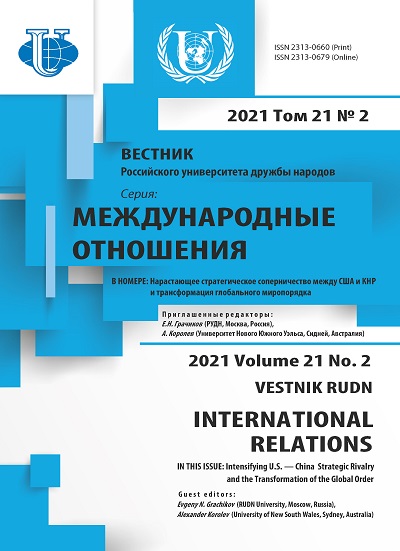United States - China Relations: Prospects during Xi - Biden Tenure
- 作者: Kondapalli S.1
-
隶属关系:
- Jawaharlal Nehru University
- 期: 卷 21, 编号 2 (2021): Intensifying U.S. — Сhina Strategic Rivalry and the Transformation of the Global Order
- 页面: 279-287
- 栏目: THEMATIC DOSSIER
- URL: https://journals.rudn.ru/international-relations/article/view/26777
- DOI: https://doi.org/10.22363/2313-0660-2021-21-2-279-287
如何引用文章
全文:
详细
Bilateral relations between China and the United States have become strategic in nature with implications to the rest of the world. Both have been engaging and competing on a number of issues in the recent times. While both seek security and stability so as to pursue their respective national interests, they differ on the way they pursue these. While engagement has been the dominant theme in the previous administrations, since late Trump, bilateral relations exhibited tensions on a number of issues including what China considered to be its “core interests”. China’s agenda of “keeping a low profile” has been changed to “accomplish something” and it intends to “occupy the centre stage” in the long-term. The election of Joseph Biden as the President of the US coincided with the ongoing reassessments on the bilateral relations as well as coming to the fore of tensions on a number of fronts with China. The spread of COVID-19 pandemic, decline in global growth rates, disruptions in supply chains, and the growing uncertainty have only further exacerbated the US - China relations. Below is a review of the bilateral relations in the recent times by eliciting cooperative and competitive trends between China and the US. It is argued that the US - China relations are undergoing major shifts due to the tensions even as both are for ushering in strategic stability. China’s perceptions at the leadership level, media and academic levels are outlined in brief to suggest that relations with the US are exhibiting tensions on a number of issues that pose challenges and opportunities for other countries.
作者简介
Srikanth Kondapalli
Jawaharlal Nehru University
编辑信件的主要联系方式.
Email: profsrikanthkondapalli@gmail.com
ORCID iD: 0000-0002-9559-8492
PhD, Professor in Chinese Studies, Centre for East Asian Studies, School of International Studies
New Delhi, India参考
- Allison, G. (2017). Destined for war: Can America and China escape Thucydides’s trap? Boston: Houghton Mifflin Harcourt.
- Anonymous. (2021). The Longer Telegram: Toward A New American China Strategy. The Atlantic Council. Retrieved from https://www.atlanticcouncil.org/wp-content/uploads/2021/01/The-Longer-Telegram-Toward-A-New-American-China-Strategy.pdf
- Askari, M.U., & Tahir, M. (2020). Sino-US rivalry in the South China Sea: A hegemonic stability theory perspective. Journal of Politics and International Studies, 6(2), 115-127. Retrieved from http://pu.edu.pk/images/journal/politicsAndInternational/PDF/8_v6_2_2020.pdf
- Boylan, B.M., McBeath, J., & Wang, B. (2021). US - China relations: Nationalism, the trade war, and COVID-19. Fudan Journal of the Humanities and Social Sciences, 14(1), 23-40. https://doi.org/10.1007/s40647-020-00302-6
- Chi, M., & Qiao, L. (2020). A skeletal review of the Sino-US “trade war”: Contentious issues, trade multilateralism and policy recommendations. Canadian Foreign Policy Journal, 26(1), 99-107. https://doi.org/10.1080/11926422.2019.1685557
- Fels, E. (2016). Shifting power in Asia-Pacific? The rise of China, Sino-US competition and regional middle power allegiance. Switzerland: Springer. https://doi.org/10.1007/978-3-319-45689-8
- Gopal, P. (2017). Maritime security in the Indo-Pacific: The role of the US and its allies. Maritime Affairs: Journal of the National Maritime Foundation of India, 13(1), 27-40. https://doi.org/10.1080/09733159.2017.1321208
- Kubo, F. (2019). Reading the Trump administration’s China policy. Asia-Pacific Review, 26(1), 58-76. https://doi.org/10.1080/13439006.2019.1633153
- Lampton, D.M. (2013). A new type of major-power relationship: Seeking a durable foundation for US - China ties. Asia Policy, (16), 51-68.
- Liu, X. (2021). Chinese multinational enterprises operating in Western Economies: Huawei in the US and the UK. Journal of Contemporary China, 30(129), 1-42. https://doi.org/10.1080/10670564.2020.1827351
- Lysne, O. (2018). The Huawei and Snowden questions: Can electronic equipment from untrusted vendors be verified? Can an untrusted vendor build trust into electronic equipment? Switzerland: Springer. https://doi.org/10.1007/978-3-319-74950-1
- Odgaard, L. (2007). The balance of power in Asia-Pacific security: US - China policies on regional order. The Korean Journal of Defense Analysis, 19(1), 29-46. https://doi.org/10.1080/10163270709464126
- Oliveira, A.C.G.D. (2021). From panda to dragon: An analysis of China’s maritime actions and reactions in the East China Sea and their implications since 2012. Contexto Internacional, 43(1), 147-171. https://doi.org/10.1590/s0102-8529.2019430100007
- Qiu, L.D., & Wei, X. (2019). China - US trade: Implications on conflicts. China Economic Journal, 12(2), 175-194. https://doi.org/10.1080/17538963.2019.1598014
- Rosen, D.H., & Hanemann, T. (2014). The changing US - China investment relationship. China Economic Journal, 7(1), 84-102. https://doi.org/10.1080/17538963.2013.874071
- Sargent, D.J. (2014). A superpower transformed: The remaking of American foreign relations in the 1970s. Oxford: Oxford University Press.
- Sutter, R. (2020). China’s relations with the United States. In D. Shambaugh (Eds.), China and the world (pp. 211-232). Oxford: Oxford University Press.
- Swaine, M.D. (2018). Chinese views of foreign policy in the 19th party congress. China Leadership Monitor, 55(23), 1-13. Retrieved from https://carnegieendowment.org/files/clm55-ms-final.pdf
- Tao, W. (2015). A brief history of China - US relations, 1784-2013. Beijing: Foreign Languages Press.
- Wang, D. (2010). China’s trade relations with the United States in perspective. Journal of Current Chinese Affairs, 39(3), 165-210. https://doi.org/10.1177/186810261003900307
- Wu, X. & Green, M. (2014). Regional security roles and challenges. In N. Hachigian (Eds.), Debating China. The U.S. - China relationship in ten conversations (pp. 198-220). Oxford: Oxford University Press.
- Yang, J. (2020). Major power relations in a post-pandemic world order. China Quarterly of International Strategic Studies, 6(1), 1-18. https://doi.org/10.1142/S2377740020500074
- Yang, X. (2021). US - China crossroads ahead: Perils and opportunities for Biden. The Washington Quarterly, 44(1), 129-153. https://doi.org/10.1080/0163660X.2021.1894723
- Ye, X. (2020). Explaining China’s hedging to the United States’ Indo-Pacific strategy. China Review, 20(3), 205-238.
- Yetiv, S.A. & Oskarsson, K. (2018). Challenged hegemony: The United States, China, and Russia in the Persian Gulf. Stanford: Stanford University Press.
- Zuo, X. (2021). The Trump effect: China’s new thoughts on the United States. The Washington Quarterly, 44(1), 107-127. https://doi.org/10.1080/0163660X.2021.1893515








